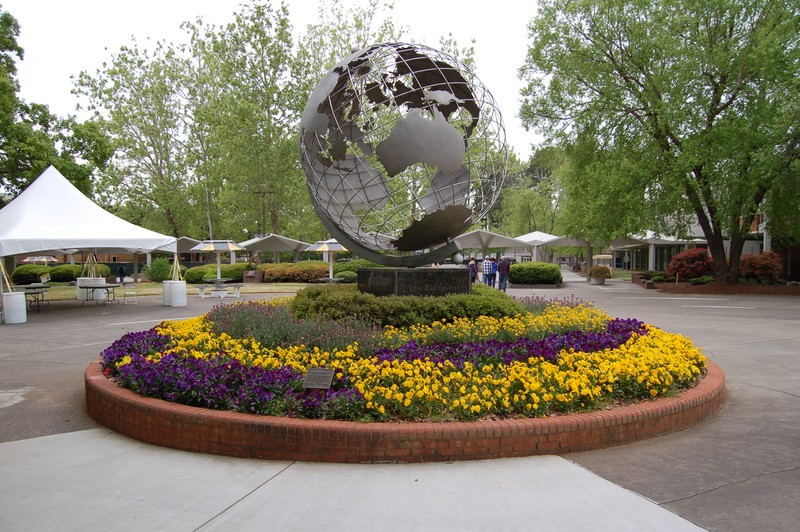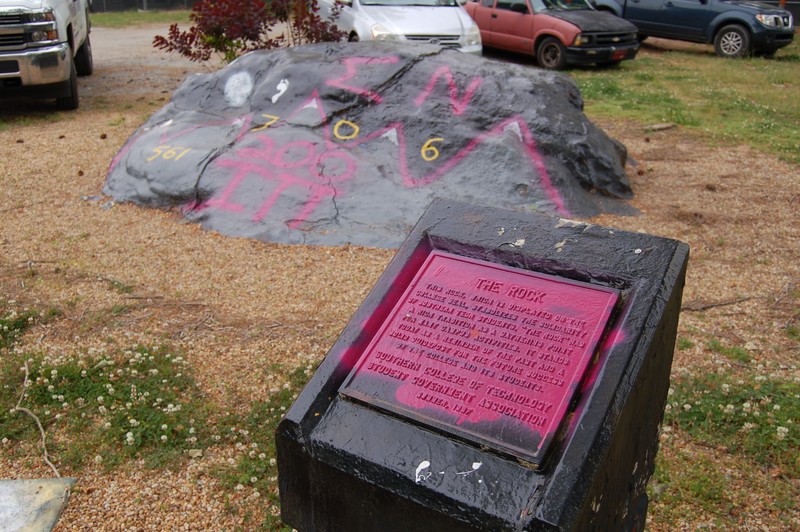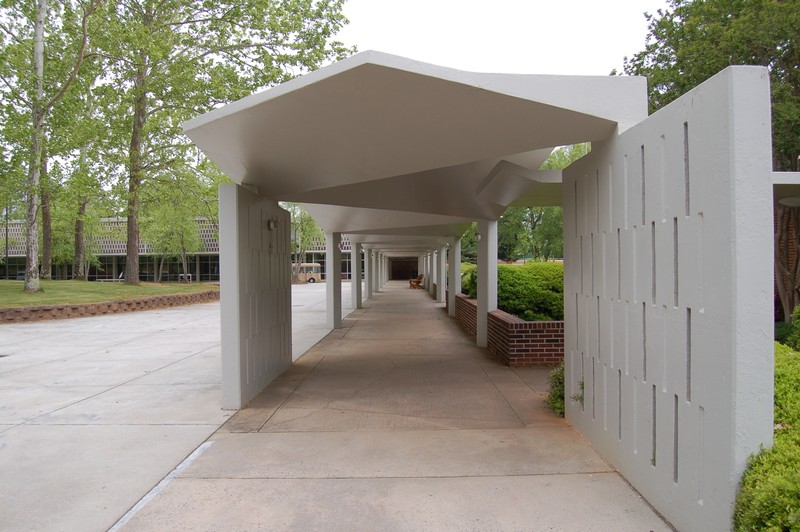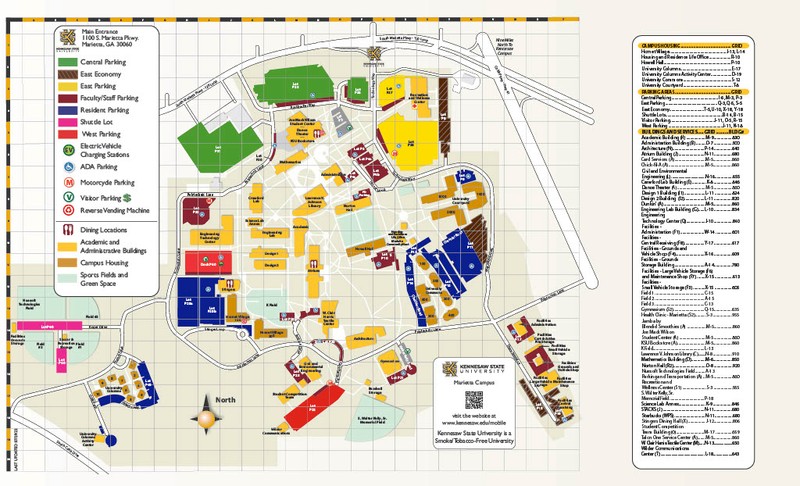Kennesaw State University - Marietta Campus
Introduction
Text-to-speech Audio
Established in 1948 as The Technical Institute in Chamblee, Georgia, this educational institution moved to Marietta, Georgia, in 1962. The school, which operated as a unit of the Georgia Institute of Technology (Georgia Tech) was known as the Southern Technical Institute (STI) at the time of its relocation to Marietta. STI became independent of Georgia Tech in 1980. The name was changed to Southern College of Technology in 1987 and to Southern Polytechnic State University (SPSU) in 1996. At the direction of the University System of Georgia Board of Regents, SPSU merged with Kennesaw State University (KSU) in 2015. The combined institution is now known as Kennesaw State University with two campuses, one in Kennesaw (the original KSU campus) and one in Marietta (the former SPSU campus).
Images
The centerpiece of the SPSU campus was this globe, which was erected in 1996.

This limestone protrusion known as "The Rock" has long been a symbol of the institution.

A concrete canopy covers the walkway that connects the Mathematics Building to the Johnson Library.

Current map of the KSU Marietta Campus

Backstory and Context
Text-to-speech Audio
The origins of KSU's Marietta campus go back to the late 1940s when Blake Van Leer, president of Georgia Tech, successfully advocated for the establishment of a technical institute to train "technicians" for industry. The Technical Institute, as it was first called, was founded in Chamblee, Georgia, in 1948. More than 100 students attended classes that first year on the site of the Naval Air Station in Chamblee, now part of DeKalb-Peachtree airport. The name was changed to the Southern Technical Institute (STI) in 1949.
By the late 1950s, the facilities at the Naval Air Station proved inadequate, and the Board of Regents (BoR) of the University System of Georgia (USG) began exploring sites for a bigger, more permanent home for the institution. STI relocated to its current site in Marietta in 1962 after Cobb County donated approximately 120 acres and the City of Marietta offered to make infrastructure improvements. Although groundbreaking for the new campus took place in December 1958, construction was delayed over the next several years by controversies associated with a nearby housing complex, labor disputes, and weather. The new campus opened with only two of its eight buildings completed in fall 1961. The remaining six buildings were completed over the next 18 months, as was the initial landscaping. During this period, a limestone protrusion was discovered in the space that would become the first campus green, and Professor Chester Orvold mounted a successful campaign to preserve the protrusion, which became known as "The Rock." The Rock still stands in its original location and is the scene of contests between student organizations.
In the mid-1960s two residence halls were added to the campus as was the Lawrence V. Johnson Library. The library has been expanded several times since its opening in 1968, most recently in the early 2020s. The Joe Mack Wilson Student Center opened in 1977. Additional academic buildings were added in the 1980s and 1990s, including the W. Clair Harris Apparel and Textile Center, built in 1988, and the Atrium Building designed by renowned architect John Portman, which opened in 1999. Two new residential complexes opened in the early 2000s--University Commons on the southeast corner of the campus in 2000 and University Courtyard on the east side of the campus in 2004. The Architecture Building, located on the south side of the campus near the 1966 Gymnasium, opened in 2001. More residential buildings and a dining hall were added in 2010 when Stingers Restaurant and Hornet Village opened on the southwest side of the campus. That same year, the 130,000-square-foot Engineering Technology Center opened on the west side of campus.
For the first 32 years of its existence, the institution operated as a unit of Georgia Tech. In 1980, STI became an independent unit of the USG. Dr. Stephen Cheshier, named president that same year, led the institution for seventeen years during which time it underwent two more name changes -- Southern College of Technology in 1987 and Southern Polytechnic State University (SPSU) in 1996. On November 1, 2013, USG Chancellor Hank Huckaby announced that SPSU and Kennesaw State University (KSU) would merge into a single institution as part of a systemwide plan to reduce costs. At the time, SPSU had approximately 6,500 students enrolled, many of whom were unhappy about the merger. Following an on-campus protest by students on November 5, the iconic SPSU globe located in the center of the Upper Campus Plaza was dislodged from its base. Students had climbed on the globe earlier in the day to paint messages of protest and had, perhaps, damaged the structure, causing it to break off its base. In spite of the protests, the merger proceeded. The consolidation of the two universities into a single entity under the name Kennesaw State University was completed by January 2015. Since that time, the former SPSU has been known as Kennesaw State University Marietta Campus. The Southern Polytechnic name has been preserved as the name of the College of Engineering and Engineering Technology, which, with more than 5,000 students, is the second-largest engineering college in Georgia.
Sources
Bennett, Richard A.. Southern Polytechnic State University: The History. Edition First. Marietta , GA. SPSU Foundation, 1997.
Lord Aeck & Sargent. SPSU Campus Historic Preservation Plan. Atlanta, GA. Lord Aeck & Sargent, 2013.
Tagami, Ty. "Kennesaw State, Southern Poly to merge." Atlanta Journal-Constitution (Atlanta) November 1st, 2013.
Jennifer Dickey
Jennifer Dickey
Jennifer Dickey
https://maps.kennesaw.edu/
